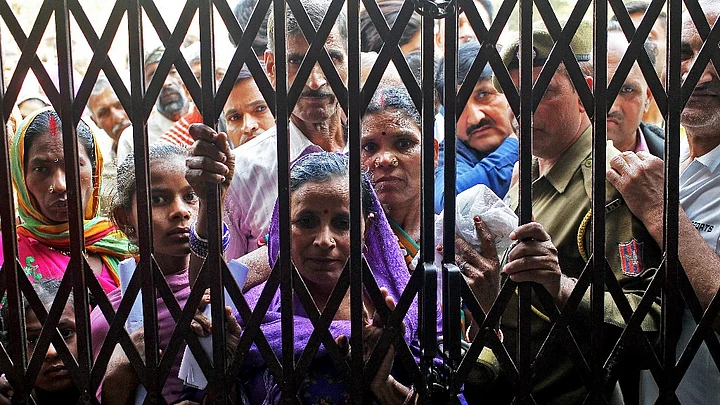A savings deposit is the most basic of banking products. Everyone who has a bank account has one. It’s also the place where millions of Indians, not well versed with more complex financial products, keep their savings. For those reasons, the interest rate on savings deposits was kept regulated well after the setting of all other interest rates was left to market forces.
In October 2011, D Subbarao, the then governor of the Reserve Bank of India, decided to deregulate the savings deposit rate.
In the five years since, most major banks have kept their savings deposit rate unchanged at 4 percent. While smaller private banks have experimented with higher rates, the top banks have all retained the rate at 4 percent irrespective of liquidity conditions.
It now looks like banks may be considering moving on this crucial rate. Only, the move being considered is a cut rather than an increase.
In a conversation with BloombergQuint , Arundhati Bhattacharya, Chairman of State Bank of India, the country’s largest bank, said that liquidity conditions have changed substantially due to the withdrawal of Rs 500 and Rs 1,000 notes.
The demonetisation decision, announced on November 8, has led to nearly Rs 13 lakh crore in old currency being deposited into banks. Bankers estimate that a material amount of these deposits may not flow back out, which will lead to a durable change in the liquidity position of the banking sector.
It’s difficult at this point of time to say which way we will move but it is definitely something that we need to look at given that there is so much liquidity and there is so little credit offtake. We do want to incentivise people to start taking loans. And to do that, we need to bring down the rates of interest.Arundhati Bhattacharya, Chairman, State Bank of India
“I think the jury is still out on how much of the deposits will flow back out. At one point, I thought about 15 percent will remain. But some of the other bankers feel that more than 30-40 percent of the money coming into savings bank accounts may not flow back out...” said Bhattacharya while adding that if the increase in digital transactions sticks, then about 30 percent of the cash may stay back in the banking system.
When asked whether the additional liquidity will prompt bankers to cut the savings deposit rate, Bhattacharya said that it is possible.
SBI had savings account deposits worth Rs 6.41 lakh crore as of end of September 2016, showed an analyst presentation made by the bank after its quarterly earnings. This was 34 percent of its total deposit base of Rs 18.6 lakh crore.
Banks Flush With Deposits
The change in liquidity conditions is undeniable.
- For the fortnight ended December 9, deposits rose 15.9 percent compared to 10.9 percent in the comparable quarter last year
- During the same fortnight, credit rose just 5.8 percent compared to 10.6 percent in the same period last year last year
- The credit-deposit ratio of banks is down to 69.3 percent compared to 75.9 percent same time last year.
It is this change in dynamics that has prompted banks to consider a cut in the savings deposit rate. The first hint of this came in a pre-budget meeting between bankers and finance ministry officials earlier this week. At the meeting, bankers suggested that the government consider some incentives for senior citizens to protect them against any possible decline in interest rates.
Post-demonetisation, liquidity in banks have improved. This may impact saving deposit rates. This makes senior citizens more vulnerable as their income is adversely affected. So, some sort of exemption needs to given to them under the Income Tax Act so that they have a decent income through their deposits.Finance Ministry’s press statement on suggestions from bankers ahead of Budget 2017
Not An Easy Decision
Unlike adjustments in fixed deposit rates, which tend to respond quickly to changes in liquidity conditions, a change in the savings deposit rate is not an easy decision.
According to the latest data available from the RBI, the overall pool of deposits in the banking sector stood at Rs 108 lakh crore. Of this, demand deposits (including current accounts and savings accounts) stood at Rs 11 lakh crore. This, known as CASA deposits in banking parlance, is the base of low cost deposits for banks since they pay no interest on current accounts and 4 percent on savings account (except for a few new private sector banks which pay a higher rate).
Banks tend to protect this base of low cost deposits from volatility in rates to ensure there is some predictability in their cost of funds. As such, a decision to cut the savings deposit rate may not be taken lightly.
According to Siddharth Purohit, analyst at Angel Broking, a cut in the savings deposit rate can’t be ruled out.
“There is definitely enough reason to cut deposit rates now. Banks will certainly cut fixed deposit rates early next year but a cut in savings deposit rate can’t be ruled out as well,” said Purohit while adding that banks are in difficult position as credit is not picking up and yields on government bonds have also fallen.
“Their incremental margins will be under the pressure so they may consider a cut but it may not be substantial,” said Purohit.
This article was originally published on BloombergQuint.
